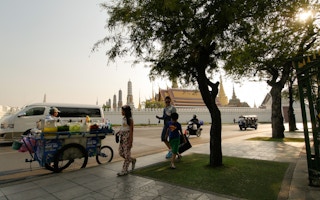It’s monsoon season in Asia – marking an end to months of scorching temperatures. But the extreme heat will return, with cities facing particularly brutal conditions. Already, Asia’s urban areas experience twice as many hot days as its rural areas do – and could experience ten times as many by 2100. At that point, there will be no reversing the trend.
To continue reading, subscribe to Eco‑Business.
There's something for everyone. We offer a range of subscription plans.
- Access our stories and receive our Insights Weekly newsletter with the free EB Member plan.
- Unlock unlimited access to our content and archive with EB Circle.
- Publish your content with EB Premium.
The first detailed assessment of climate risk for Asia, carried out by the Asian Development Bank (ADB) and the Potsdam Institute for Climate Impact Research (PIK), makes clear that Asia’s cities stand at the frontline of the fight against climate change. Indeed, many consequences of a hotter planet – such as more extreme weather events, sea-level rise, environmental migration, and mounting social tensions – intersect in urban areas.
This is particularly true in Asia, where cities house more than half of the population and produce almost 80 per centof economic output. By 2050, Asia’s urban population could nearly double, to three billion people. Without new climate initiatives, the region’s cities could contribute more than half of the increase in global greenhouse-gas emissions over the next 20 years.
Such a scenario is often called “business as usual.” Yet, in reality, it is business as usual that would be disrupted by the consequences of climate change, with unfettered warming impeding or even reversing Asia’s recent economic progress.
The longer we wait to address the climate challenge, the more devastating the disruption will be. And we may not get much warning, because climate effects generally do not evolve in a linear fashion, but rather emerge suddenly and powerfully, once certain tipping points have been reached.
So far, not nearly enough has been done to assess Asia’s exposure to climate impacts, much less to strengthen protections for vulnerable areas or reduce greenhouse-gas emissions.
The region needs low-carbon green growth strategies that use less land, water, and energy. These strategies will help to slow rapid urbanization, which entails dense construction, sealed roads, and private cars – all of which contribute to the “urban heat island” effect.
If we continue on our current path, the mean temperature over the Asian landmass could soar by more than 6°C (10.8°F), relative to pre-industrial levels, by 2100. People may fall ill and even die from respiratory and other ailments caused by heat stress or pollution. Beyond the human costs, higher temperatures would undermine agricultural and industrial productivity.
Climate-driven migration flows will exacerbate the challenges Asian cities face. Unless a sufficient number of decent jobs are created, climate migrants could become a permanent underclass. Even if jobs are available, the environmental pressure created by ever-more populated cities will pose a grave threat.
Yet projections of the impact of climate change on migration in Asia remain indefensibly limited in number, scope, and predictive power.
“
If, however, we continue on our current path for just a couple more decades, we could trigger centuries of rising sea levels, even if we subsequently ended all greenhouse-gas emissions. The effects would be gradual but merciless.
In order to improve city planning and health-care services, we need a simple and accurate way to assess current and future heat-tolerance levels among urban populations.
We also need strategies to decrease urban heat stress, including a shift toward polycentric urban configurations, with economies and societies built around multiple regional hubs, rather than concentrated around a single city, and natural assets maintained through eco-corridors and connected green spaces.
But rising temperatures are far from the only threat posed by climate change. Extreme weather events, from droughts to floods, will intensify and become more frequent. In Asia, increased rainfall and worsening tropical cyclones will wreak havoc on food production, driving down rural incomes. In Sri Lanka, for example, rice yields could drop by up to 20 per cent by 2050; in Fiji, cassava output could plummet by 36 per cent.
All of this would be exacerbated by rising sea levels, which could be 1.4 meters (4.6 feet) higher by the end of the century, potentially causing many countries to lose more than 10 per cent of their land area. If countries meet their commitments under the Paris climate agreement, the total sea-level rise could be halved, with more ambitious schemes promising even greater reductions.
If, however, we continue on our current path for just a couple more decades, we could trigger centuries of rising sea levels, even if we subsequently ended all greenhouse-gas emissions. The effects would be gradual but merciless.
The risks are arguably highest on Asia’s crowded coastlines, where millions of people are exposed to flooding. And those risks continue to mount: in countries such as Bangladesh, India, the Philippines, and Vietnam, coastal populations are expected to double by 2060. Asia is home to 13 of the 20 global cities expected to experience the sharpest increases in annual economic loss due to floods between now and 2050.
As it stands, the risks of sea-level rise for Asia’s coastal urban centers are still not sufficiently understood, nor have they been adequately integrated into planning processes. This must change. In flood-prone countries, city-planning schemes should blend gray infrastructure, such as drainage systems, dikes, and sea walls, with green measures, like conservation of wetlands and forests. Improved meteorological observations and early-warning systems would also help substantially.
But here, again, there is a lack of adequate knowledge and preparation. There is no systematic analysis of the economic costs and benefits of coastal fortification relative to other approaches. “Softer” interventions, like better land-use planning and ecosystem-based approaches, are widely supported, but their effectiveness has been assessed in only a few small-scale studies.
Flood risks could complicate energy-infrastructure development in coastal cities in countries like Bangladesh and India. Here, at least, the way forward is clearer: closer regional cooperation would help to offset power shortages, while off-grid energy from renewables and climate-resilient supply networks would help countries to enhance their energy security.
Given Asia’s massive size, population, and economic importance, it must be at the center of global efforts to mitigate climate change. In many ways, Asia’s cities hold Earth’s future in their hands. They must do their utmost to protect it.
Hans Joachim Schellnhuber is the Director of the Potsdam Institute for Climate Impact Research. Bambang Susantono is the Asian Development Bank’s Vice-President of Knowledge Management and Sustainable Development.
Copyright: Project Syndicate, 2017.
www.project-syndicate.org












